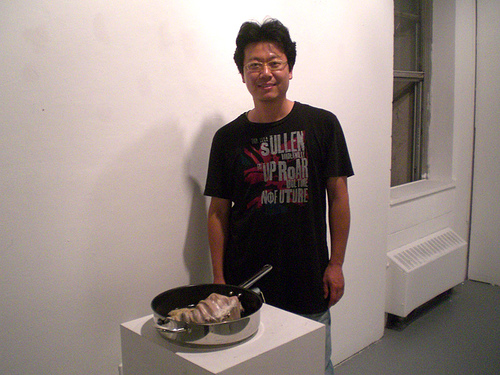 A week ago or so, i read on boingboing and other blogs, many other blogs, about the work of Doo Sung Yoo. Actually i didn’t read much, there were just a few words that accompanied a couple of videos of robotic cow tongues and robotic pig stomachs. I started wondering what was behind the spectacular art works. Who is the artist? How did he get interested in robotic and organic pieces? Were they just gimmicks? So i just asked him…
A week ago or so, i read on boingboing and other blogs, many other blogs, about the work of Doo Sung Yoo. Actually i didn’t read much, there were just a few words that accompanied a couple of videos of robotic cow tongues and robotic pig stomachs. I started wondering what was behind the spectacular art works. Who is the artist? How did he get interested in robotic and organic pieces? Were they just gimmicks? So i just asked him…
What is your background?
My curiosity about new media arts and mixed media takes me into new areas of study and new major fields. I am from Seoul, South Korea. Before I came here, I was an animator and instructor at Ye-won Arts University. When I was studying for my first B.F.A in Graphic Design in my country, I tried my hand at motion illustrations rather than still graphic images. The university rewarded me by allowing me to study professional animation to gain more advanced experience. For that reason, I worked in an animation studio as animator. After I improved my skills in Digital Animation, I began studying for my M.F.A in Multimedia Animation. During that period, I made experiments on interactive animations with performances. For the projects, I tried interactions between animation and dancing. Although the music, animation, and dance were harmonized through a detailed script, I could not perfectly complete real-time interactions due to poor information about interactive installation in my country. Though I was able to acquire a position as a faculty member teaching I decided to leave my university position in order to move to the USA to study interactive art techniques.
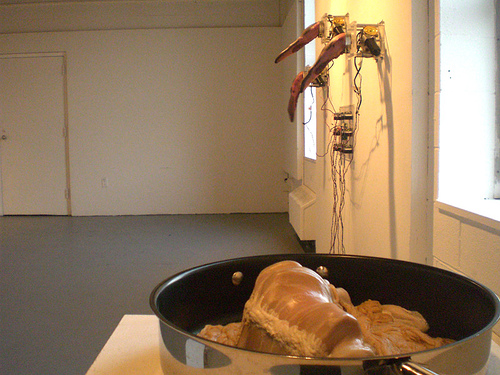 Lies and indigestion at the show
Lies and indigestion at the show
You are a student at the Ohio State University, right?
I am in the Art and Technology B.F.A. major in the Department of Art at the Ohio State University. Last Thursday, June 7, I showed my senior exhibition, in which the robotic cow tongues and a kinetic pig stomach were displayed as part of a series called the Body and Organ Project. Fortunately, the department accepted me in the graduate program, so I can continue to study in this area with the great faculty, colleagues, and alumni of OSU.
My focus is on an intensive study in advanced and mixed real-time interactive media, as well as discovering entirely new media. To achieve success with my works, I am studying laser processes, robotic arts, and visual images that are controlled by interactive computer programming and other electronic equipment. Last quarter, I have made an entertainment urinal, After Duchamp, a distance-activated audio and laser installation. I finally could give Duchamp, who gave me many motivations, a tribute through my technically upgraded urinal. Now, I am launching my new challenge in biotechnology and art, to find new possibilities for my art works.
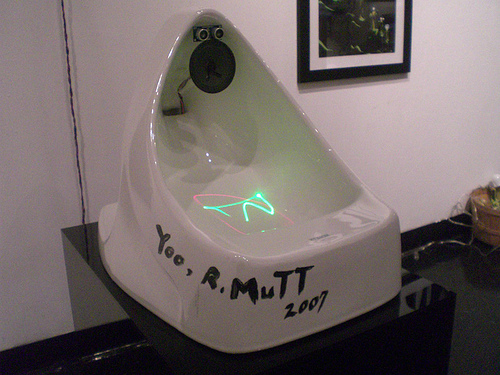 After Duchamp
After Duchamp
Why robotic tongue cows?
The robotic cow tongues and the pig stomach are also parts of a series in the Body and Organ Project. There are many representations in these works; one is that robotic and electronic elements with organs represent advanced biological technology. Today’s medical science can support replacing diseased human organs with new animal organs. If medical science can change all of a human’s organs and add extra functions, much like a computer upgrade, how we can give a definition for a human’s body? For many years now, I have been interested in the body’s biological change in relation to an increasingly technologized society.
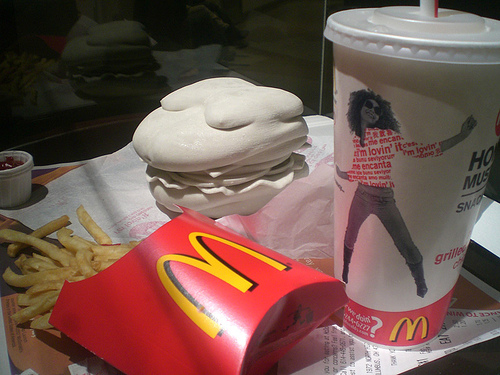 In autumn of 2006, I conceptualized and created a 3D sculpture in a course focused on 3D modeling sculpture and rapid prototyping. The final work combined the forms of a hamburger and fat human torso, Hamburgerbody, which is also a part of the series, Body and Organ Project. This piece represents how the human body is damaged due to fast food in modern life, although high technology is solving old medical problems. It is a strange paradox in our society. Hamburgerbody represents damaging or deforming the human body as in decay, however, the robotic cow tongues and pig stomach represent developing or changing an organ as a technological advance.
In autumn of 2006, I conceptualized and created a 3D sculpture in a course focused on 3D modeling sculpture and rapid prototyping. The final work combined the forms of a hamburger and fat human torso, Hamburgerbody, which is also a part of the series, Body and Organ Project. This piece represents how the human body is damaged due to fast food in modern life, although high technology is solving old medical problems. It is a strange paradox in our society. Hamburgerbody represents damaging or deforming the human body as in decay, however, the robotic cow tongues and pig stomach represent developing or changing an organ as a technological advance.
Another representation is that the cow tongues are jeering at current artists’ focus on fame and popularity for commercial success with insensibility to immoral acts in contemporary art. To express tongues’ jeering movement, I needed a robotic and electronic device. Nowadays, we are surrounded in numerous images and texts due to powerful mass media. People became hardened due to vulgar acts and shock images in mass media. Now many artists are willing to take any risk with shock images and acts for success in market-driven art without considering aesthetic viewpoints. For example, in Nam June Paik’s the first solo exhibition (and the first video art show in modern art), Electronic Television and Exposition of Music, Wuppertal, Germany, 1963, he hung a cow’s bleeding head on a gateway of the gallery. In the same year, Joseph Beuys also hung a dead animal, a rabbit, on a chalkboard for his performance in Festum Fluxorum Fluxus. In Fluxus most active period, 1965, Damien Hirst was born in England. He exhibited cow carcasses and other dead animals as art too, in the 1990s. Marco Evaristti, a notorious shock artist, shot running rats in his performance, Election Day, God save Denmark, 2001. This January 2007, he ate meatballs which were taken from his own body fat by liposuction and the meatballs were displayed in a gallery. What are the different and significant points between Fluxus member Mr Paik and Beuys’ barbaric acts as compared to Damian Hirst and Maroco Evaristti’s brutal art works? Fluxus’ provocative purpose of anti- art movement, frustrating the high culture and market-driven art, denying banal and serious art, and offering opposition to the ideas of tradition and professionalism, at least contributed and had influences on contemporary art, especially multimedia performance and video art. How about current shock artists’ purposes? Are they getting a free ride in the art bus? Are they just eating the fruit of Neo Dadaist or Fluxus’ labors? The tongues mock artists who are following popularity without purpose on a stage of immoral competition, especially acts of killing living animals or using carcasses today. Nam June Paik declared “Art is just fraud. You just have to do something nobody else has done before.â€? This quotation is full of suggestion in current art. The tongues represent Nam June Paik’s opinion. If Nam June Paik’s tongue is attached to my machine, the tongue might say, “hey, it’s not art!â€? “neh, boo, hiss!â€? The tongues also represent other current artists’ tongues. If tongues from shock artists are attached on the machine, the tongues may say that “Ladies and Gentleman! This is the art!â€? “neh, boo, hiss!â€? Which tongues are lying now?
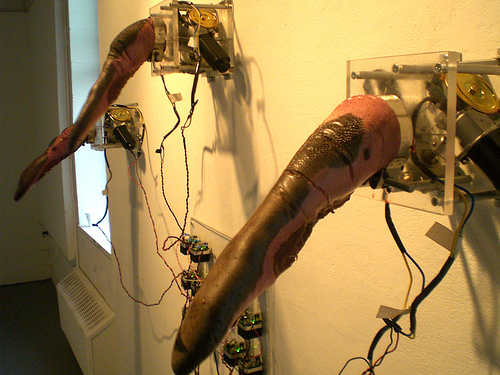 Robotic Cow Tongues
Robotic Cow Tongues
What fascinates you in this hybridization of electronics and organic?
The cow tongues and pig stomach are not living organs any more after they are cut from their original bodies. Robotic and electronic devices can give the disembodied organs new life, new position, and new function. Like surgeons’ transplant operations such as replacing a kidney, heart, or lung, artists can mix biological media with machines for new creative works. Disembodied organs that move and react through the use of robotic and electronic devices, are also a kind of animation in a different medium, recalling animation devices such as Phenakistoscope, Zoetrope, and Praxinoscope, before the invention of film. The tongue is not a tongue any more after it is attached on the machine.If someone wants to use the robotic tongue as a sex toy, the tongue can replace the toy with a new position and new function although the customer needs to change the old to the fresh meat on the machine.
What are the challenges of working with “meaty” element?
Honestly, I do not like touching raw meat though I used to eat raw meat and raw fish as these are traditional foods in Korean. Now, I am considering making a change to a vegetarian diet after this experience. The process of making this work has made me sick of bleeding raw meat. It is so terrible that I worked hard to saw, to drill, and to attach raw meat on my machine. During this period, I felt like a cruel person although the organs are just edible meat, readily available at any local butcher shop.
What were you trying to achieve or express with this work?
Developing or changing organs with machines and damaging or deforming organs will offer viewers a new meaning of the body in a high technology society. I would like to bring forth questions about whether the biological body is technologically advancing or simply decaying. Moreover, I would like to arouse artists’ attention to following fame, popularity, financial-success with the excessive and seemingly immoral concept of robotic jeering cow tongues. In the related work Indigestion,a kinetic pig stomach with a churning machine inside shows how a public cannot digest extreme immorality with commercialism.
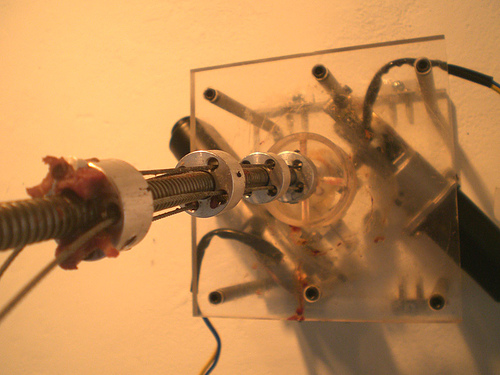 After the show
After the show
How does the public react to it?
Most viewers felt bad and uncomfortable due to the repulsive sight, but they were laughing and enjoying the strange objects. Many people asked me, “are these a kind of sex toy representing some sexual concept?� I said, “if you want it as a toy, I can make a size fit for you�.
Now how about the stomach?
The market price of Damien Hirst’s animal bodies and internal organs are very expensive now and the works are preserved as permanent and unique art works and when they are displayed they attract large crowds. For my works however, no one wants to collect the tainted organs. Moreover, I am not a famous artist, so when I buried the organs, a swarm of flies were just buzzing around and making a big noise.
How does it work technically?
I used a cam mechanism. In the stomach, different shaped discs on a crank are rotating by a gear head motor. I made smooth plastic discs to avoid damaging the thin skin. The plastic plate and motor with discs on the shaft are screwed on a pan and hold the stomach to avoid rolling. I needed to constantly spray water on the surface to prevent the tissue from drying. Ross Baldwin a Columbus artist and also a machine shop supervisor at OSU, was an important facilitator in this production.
Does your work refer or is it inspired by any other artists?
I refer to Nam June Paik and Joseph Beuys’ provocative performances, Damien Hirst’s cut up animal bodies, and Stelarc’s concept of extending the human body for my works. Ken Rinaldo and Amy Youngs’ bio-art works had influence on the works and gave me many motivations. By studying the technical mechanism of Ken Rinaldo’s Autotelematic Spider Bots and Autopoiesis: Artificial life Installation, I can solve many technical problems in my works. I really appreciate these artists’ great ideas, concepts and techniques.
Images courtesy of the artist.
